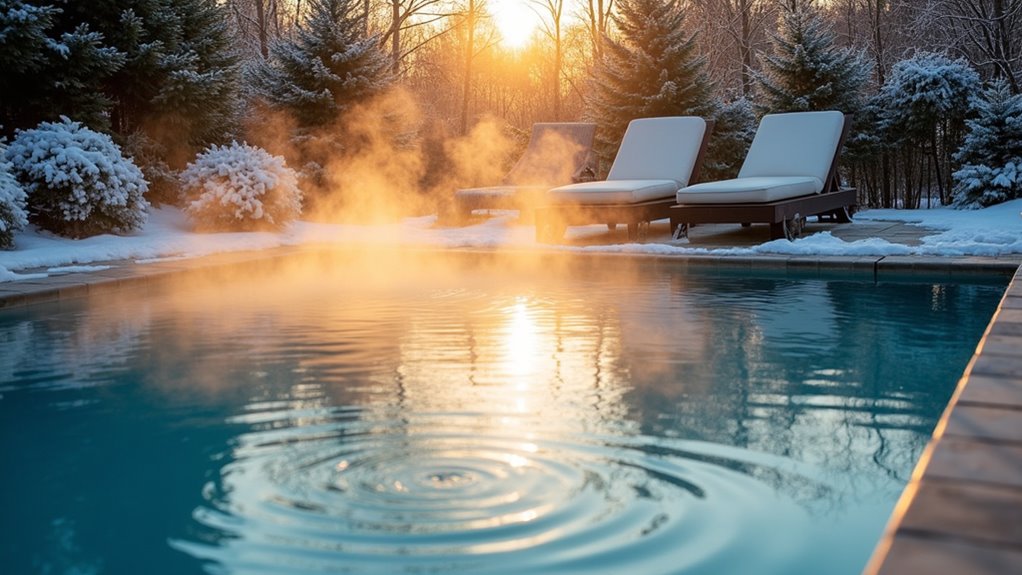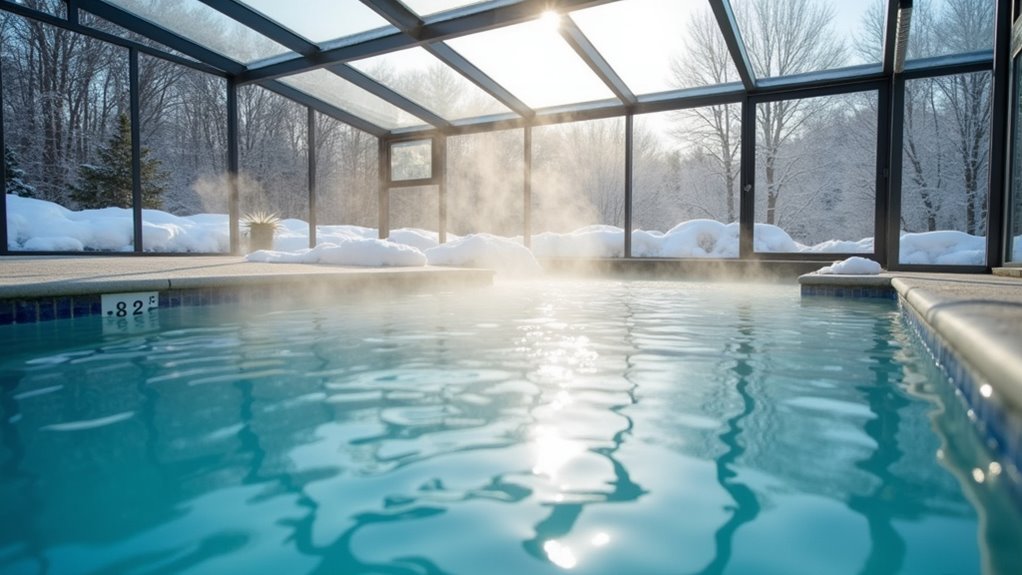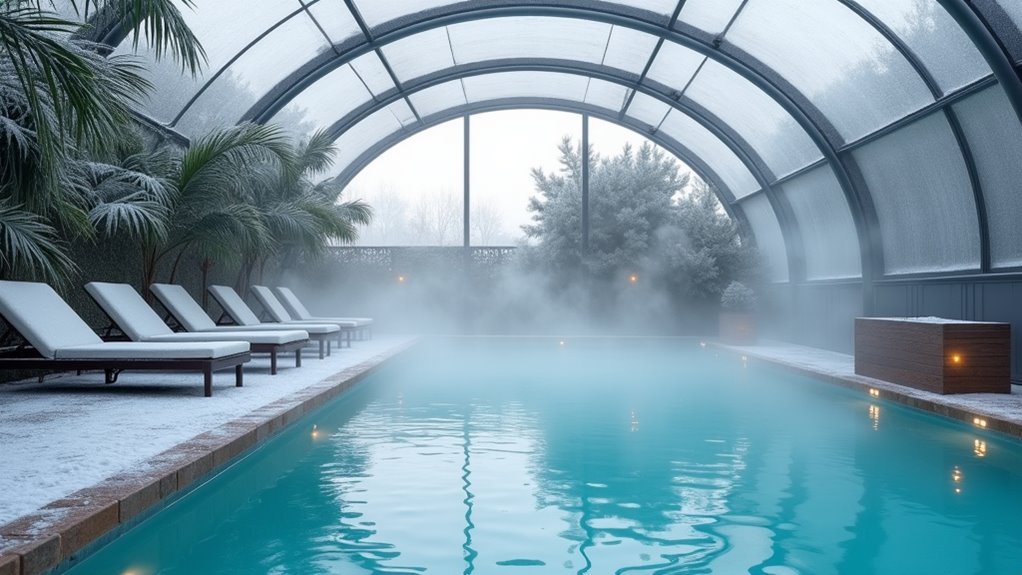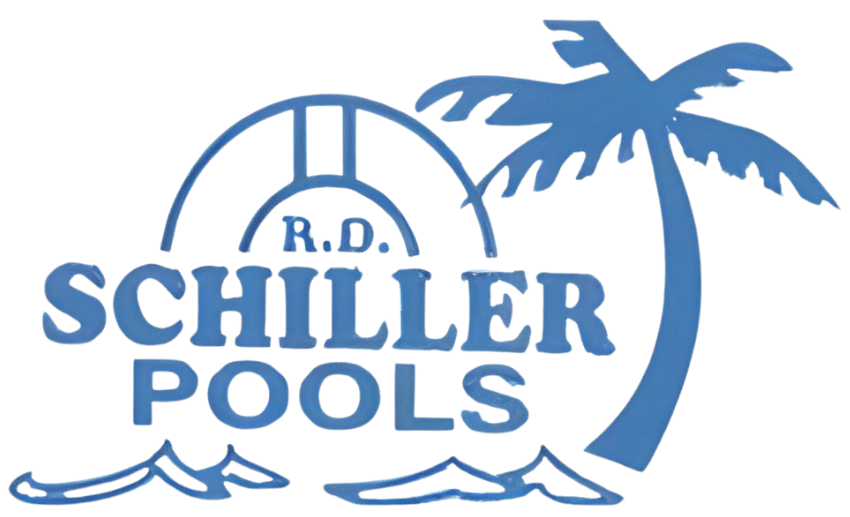To use your pool year-round, you’ll need an efficient heating system like a gas heater or heat pump to maintain comfortable water temperatures. Install a protective enclosure or cover to shield against weather and retain heat. Implement consistent maintenance with weekly cleaning, chemical balancing, and equipment checks. Add smart monitoring systems and LED lighting for augmented control. These essential elements work together to create your perfect four-season swimming environment, with many more optimization strategies to investigate.
Essential Heating Solutions for Every Season

When you’re looking to extend your pool’s usability throughout the year, choosing the right heating solution becomes essential for maintaining comfortable swimming temperatures. Your climate and usage patterns will determine the most efficient heating installation for your needs. If you encounter issues accessing manufacturer websites like secure online portals, you may need to contact their support teams directly.
For year-round swimming in cold regions, gas heaters offer the fastest heat-up times with 82-95% operational efficiency, ensuring seamless pool heating transformations between seasons. Leading manufacturers like Pentair and Hayward specialize in gas heaters designed specifically for colder climates. AquaCal HeatWave SuperQuiet models provide excellent durability and efficiency for inground pools. If you’re in a milder climate, heat pumps provide cost-effective temperature maintenance with their superior energy efficiency, though they work best above 50°F. Solar heating systems offer the lowest operational costs and environmental impact but require consistent sunlight. For small pools or spas, electric resistance heaters can work effectively, though they’ll increase your energy bills substantially. Consider combining systems for ideal performance across seasons.
Weather Protection and Enclosure Options
A well-designed pool enclosure serves as your initial line of defense against unpredictable weather while extending your swimming season. You’ll find several options to match your needs, from retractable systems with push-button operation to fixed dome structures featuring insulated framing designs. The incorporation of 6061-T6 aluminum alloy ensures exceptional durability and rust resistance for long-term reliability. For enhanced security, the structures include protective measures to safeguard against potential online threats.
For year-round protection, consider glass or polycarbonate panels that offer superior insulation while maintaining transparency. These materials integrate seamlessly with custom architectural integration requirements, adapting to your pool’s unique shape and surrounding environs. Screen enclosures provide a cost-effective solution for keeping debris and insects at bay while preserving natural airflow. Telescopic enclosures offer the versatility of multiple sliding sections that can be adjusted based on weather conditions.
Your choice of enclosure will substantially impact maintenance requirements and energy efficiency. UV-blocking features protect both swimmers and pool materials, while proper insulation helps maintain consistent water temperatures throughout changing seasons.
Year-Round Pool Maintenance Tips

Maintaining your pool year-round requires a systematic approach to cleaning, chemistry, and equipment care. You’ll need to perform regular safety checks and establish a consistent maintenance schedule that adapts to each season’s unique challenges. The need for water balancing adjustments increases significantly during warmer months when pool usage peaks. Following a proper cleaning routine daily can significantly reduce the need for expensive treatments. Establishing a detailed checklist each month helps ensure no maintenance tasks are overlooked.
| Season | Key Tasks | Safety Focus |
|---|---|---|
| Spring | Rebalance chemistry, inspect equipment | Check cover integrity |
| Summer | Increase testing frequency, monitor usage | Test emergency shutoffs |
| Fall | Augmented skimming, prepare coverage | Verify drain protection |
| Winter | Maintain water level, protect equipment | Monitor freeze conditions |
Proactive troubleshooting starts with daily skimming and weekly brushing of walls and steps. Test your water twice weekly, adjusting chemicals based on temperature and usage patterns. Don’t forget to clean your filter according to manufacturer specifications and maintain detailed logs of all maintenance activities. This systematic approach will keep your pool safe and enjoyable throughout the year.
Smart Equipment Upgrades for Extended Swimming
Modern pool equipment upgrades can transform your swimming experience from seasonal to year-round enjoyment. By installing a dual heating system with both heat pump and gas heater capabilities, you’ll maintain perfect temperatures across all seasons. Pair this with energy monitoring systems that track usage and automatically adjust settings for ideal efficiency. Smart pool systems enable automated maintenance scheduling and real-time water quality monitoring for optimal pool care. Remote access controls let you manage your pool’s functions through smartphone apps, ensuring your pool is ready whenever you want to swim. Install variable-speed pumps and LED lighting systems to reduce operating costs while extending swim hours. Don’t forget an automatic pool cover – it’s essential for heat retention and safety. These smart upgrades, combined with automated chemical monitoring and filtration systems, create a pool that’s always swim-ready while minimizing maintenance demands and energy consumption. Using a variable speed pump allows you to customize water flow rates for maximum energy efficiency and cost savings. A salt chlorination system provides easier maintenance and creates a healthier swimming environment with fewer harsh chemicals.
Seasonal Adjustments and Comfort Strategies

Successful year-round pool operation requires five key seasonal changes to maintain ideal conditions. You’ll need to adapt your chemical monitoring schedules based on temperature changes, with more frequent testing during seasonal shifts. Keep pH between 7.2-7.6 and maintain chlorine at 1-3 ppm year-round. Regular filter system checks help optimize water circulation throughout changing seasons. A routine vacuum session each week keeps the pool bottom pristine and prevents debris buildup. Professional service technicians should inspect heat pumps and equipment annually to ensure optimal performance.
| Season | Required Adjustments | Comfort Strategies |
|---|---|---|
| Spring | Weekly pH testing | Remove covers gradually |
| Summer | Daily skimming | Use supplemental ventilation systems |
| Fall | Increased brushing | Install windbreaks |
| Winter | Extended circulation | Deploy thermal covers |
Don’t forget to adjust your pump runtime, 10-12 hours in warm months and continuous operation during freezing temperatures. Strategic landscaping and thermal covers will help maintain comfortable swimming conditions year-round, while proper debris management prevents chemical imbalances. Remember to empty pump baskets weekly and maintain consistent water movement to prevent stagnation.
Frequently Asked Questions
How Much Does Year-Round Pool Maintenance Typically Cost per Month?
You’ll typically spend $100-$200 per month for year-round pool maintenance, but your costs can increase to $250-$350 when you factor in pool heating costs during colder months. You’ll need to adjust your maintenance schedule based on seasonal changes, increasing chemical treatments during warmer periods and monitoring heating systems in winter. Be prepared for higher utility bills, as running pool equipment continuously throughout the year dramatically impacts electricity costs.
Can Indoor Pools Be Converted to Outdoor Pools and Vice Versa?
Yes, you can convert pools between indoor and outdoor settings, though it’s a complex and costly undertaking. For a less permanent solution, consider installing seasonal enclosures or retractable pool covers that’ll give you flexibility throughout the year. Converting from outdoor to indoor typically costs $200,000-$500,000 and requires extensive HVAC installations, while indoor-to-outdoor conversions need significant structural removal and weatherproofing. Always consult structural engineers and obtain proper permits before proceeding.
What Insurance Considerations Should I Know for Year-Round Pool Operation?
You’ll need to maintain extensive liability coverage year-round, even during off-peak seasons. Make sure your policy doesn’t have seasonal restrictions and verify that winter-specific damages like ice pressure or freeze-thaw cycles are covered. Install and maintain proper safety precautions, including winter pool covers with locks, and keep your security fence in good condition throughout the year. Document your ongoing maintenance and safety measures to support potential claims.
How Do Different Pool Shapes Affect Heating Efficiency in Colder Months?
Your pool’s shape profoundly impacts heating efficiency during cold months. Rectangular pools have larger pool surface area, leading to greater heat loss and higher heating costs. You’ll find that circular or kidney-shaped pools retain heat better due to their compact design. To optimize efficiency, you’ll want to invest in quality pool insulation materials like fitted solar covers. Consider that irregular-shaped pools may require custom-cut covers, which can impact your comprehensive heating effectiveness.
Are There Specific Regulations for Operating Pools During Winter Seasons?
Yes, you’ll need to follow strict regulations for winter pool operation. Your local health department requires specific winter safety protocols, including freeze protection equipment and automated sensors if you’re operating in cold weather. You must conduct seasonal pool inspections and maintain proper chemical levels year-round. You’re also required to install safety covers, maintain proper fencing, and guarantee all exposed plumbing meets local building codes for freeze protection.






